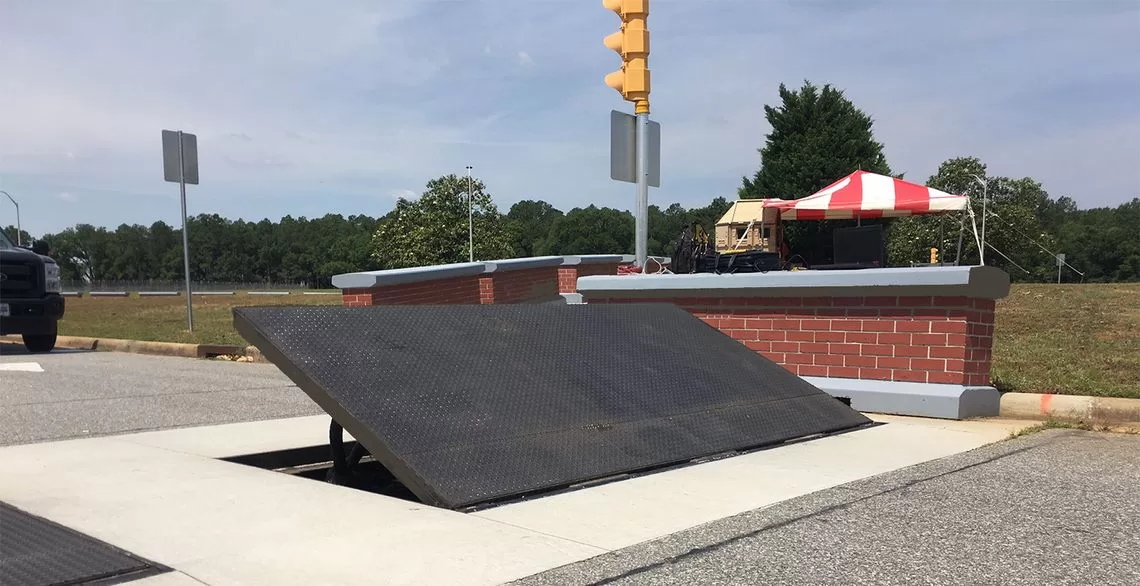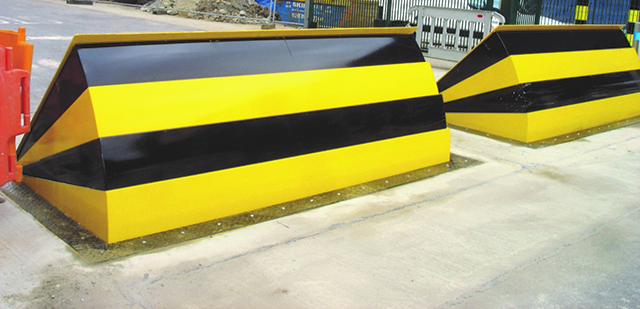Facts About Wedge Barriers Revealed


18 might be done much more rapidly, quickly, and expense successfully. FIG. In specific embodiments, the support 30 may be a steel frame including plates, light beams(e. g., I-beams ), and/or other frameworks that are safeguarded within the structure 14, which might be concrete. At the surface 12, an upper side 28 of the anchor 30 may be at least partly exposed
, consequently making it possible for the accessory of the obstacle 10 to the anchor 30. g., threaded holes)in one or even more beam of lights or plates of the support 30 might be subjected to the surface area 12. In this way, screws 32 or various other mechanical bolts might be made use of to protect the obstacle 10 to the anchor 30. As the barrier 10 is installed to the surface 12 of the structure 14, collection of particles and other material underneath the barrier may be reduced, and elements of the bather 10 might not be revealed to listed below quality environments. As suggested by referral numeral 52, the lifting mechanism 50 consists of components disposed below the wedge plate 16. For instance, the parts 52 under the wedge plate 16 might consist of an electromechanical actuator, a web cam, several web cam surface areas, and so forth. useful link In addition, the lifting system 50 Recommended Site consists of a spring assembly 54
The springtime pole 58 is paired to a cam(e. g., webcam 80 received FIG. 4) of the lifting mechanism 50. The springs 60 disposed about the spring rod 58 are held in compression by spring supports 62, including a dealt with springtime support 64. That is, the fixed spring support 64 is repaired about the structure 14 and the remainder of the bather 10.
Wedge Barriers Fundamentals Explained
The continuing to be force used to
the cam web cam deploy the wedge plate 16 may be provided supplied an electromechanical actuator 84 or other various other. The springtime setting up 54 and the actuator 84(e. Wedge Barriers. g., electromechanical actuator)may run with each other to translate the camera and raise the wedge plate 16.
As discussed above, the spring setting up 54 applies a continuous pressure on the webcam, while the electromechanical actuator may be managed to exert a variable force on the cam, consequently making it possible for the training and reducing( i. e., releasing and withdrawing )of the wedge plate 16. In specific personifications, the continuous force applied by the springtime setting up 54 might be flexible. g., electromechanical actuator) is handicapped. As will certainly be appreciated, the spring setting up 54 might be covered and shielded from particles or other aspects by a cover plate(e. g., cover plate 68 shown in FIG. 4) that may be significantly flush with the raised surface 38 of the structure 14. As pointed out over, in the released setting, important source the wedge plate 16 offers to block access or traveling past the obstacle 10. For instance, the barrier 10(e. g., the wedge plate 16 )may block pedestrians or cars from accessing a property or path. As gone over above, the barrier 10 is affixed to the anchor 30 protected within the foundation 14,

front braces 71. Consequently, the link settings up 72 may pivot and turn to allow the collapse and expansion of the link settings up 72 throughout retraction and deployment of the bather 10. The linkage assemblies 72 cause movement of the wedge plate 16 to be restricted. For instance, if a car is taking a trip in the direction of the released wedge plate 16(e. For instance, in one scenario, the security legs 86 might be prolonged duringupkeep of the barrier 10. When the safety legs 86 are released, the security legs 86 support the weight of the wedge plate 16 against the surface 12. Therefore, the lifting mechanism 50 may be shut down, serviced, gotten rid of, changed, etc. FIG. 5 is partial viewpoint view of an embodiment of the surface-mounted wedge-style barrier 10, illustrating the web cam 80 and the webcam surfaces 82 of the training device 50. Especially, 2 webcam surface areas 82, which are referred to as lower camera surfaces 83, are positioned below the webcam 80. The reduced web cam surface areas 83 might be dealt with to the surface 12 (e. For example, the lower webcam surfaces 83 and the mounting plate 85 may create a solitary item that is protected to the support 30 by bolts or other mechanical bolts. Furthermore, 2 webcam surface areas 82, which are referred to as top web cam surfaces 87, are positioned over the camera 80 and paired to (e. In various other embodiments, stepping in layers or plates may be positioned between the surface area 12 and the lower cam surfaces 83 and/or the wedge plate 16 and the top webcam surface areas 87 As pointed out over, the web cam
80 converts along the camera surface areas 82 when the wedge plate 16 is lifted from the retracted setting to the released setting. In addition, as mentioned over, the springtime setting up 54 (see FIG. 3 )might supply a force acting on the webcam 80 in the instructions 102 via spring pole 58, which might lower the pressure the electromechanical actuator 84 is needed to use to the webcam 80 in order to actuate and lift the wedge plate 16. 1 )to the deployed setting(see FIG. 4). As shown, the webcam 80 includes track wheels 104(e. g., rollers), which contact and equate along the camera surfaces 82 during procedure.